The Xiaomi Mi Note Pro and Mi Note Review
by Joshua Ho on September 11, 2015 9:00 AM ESTSystem Performance
Performance may be a rather nebulous thing - there are a number of factors that affect the performance of a smartphone in everyday tasks. One of the single most important components to overall performance is the SoC (System on a Chip). This one package will usually contain the CPU, GPU, DRAM interface, a number of fixed-function blocks, various DSPs, and other processing engines. Usually, DRAM itself is also mounted on top of the SoC package in a package on package (PoP) configuration. In order to test this and more in a smartphone, we rely on a set of benchmarks that are accepted within the industry that can reasonably represent smartphone performance. Of course, the state of the art in benchmarking is always changing, but we can say with reasonable confidence that if a smartphone or tablet performs well in our benchmarks that the SoC will be a good foundation for a smooth experience. Of course, if an OEM then decides to run unoptimized Android UIs on top of this SoC then any performance advantage could be wasted. In the case of the Mi Note, we’re looking at a relatively standard Snapdragon 801 with 3GB of LPDDR3, while the Mi Note Pro uses a more powerful Snapdragon 810 with 4GB of LPDDR4.


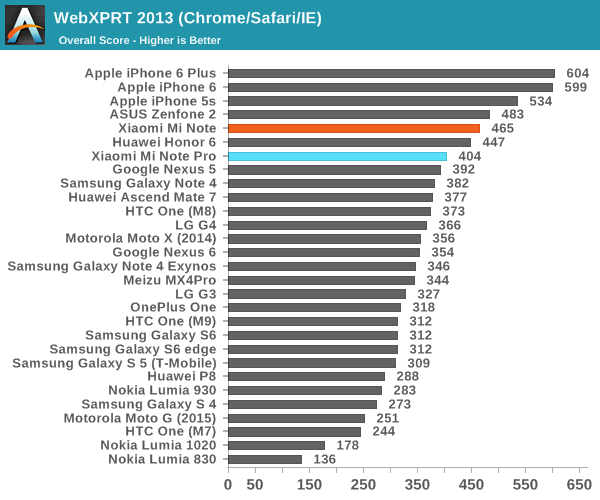
It's interesting to look at these results as we can basically see the differences that result from browser optimizations. It's also important to note here that the Xiaomi Mi Note was run with the Performance mode turned on as otherwise the CPU governor would be far too conservative for good performance. Unfortunately though, it looks like the Performance mode (as opposed to Balanced) is extremely aggressive, setting all cores online and to only use the 2.5 GHz state. Xiaomi needs to provide a more appropriate performance governor for everyday use. It's worth noting here that all benchmarks can be run without the performance governor, but the software will offer to turn it on if it detects a benchmark.
Fortunately, it seems the Mi Note Pro doesn't have these sorts of strange governor settings and performance is in line for what we'd expect from a Snapdragon 810.
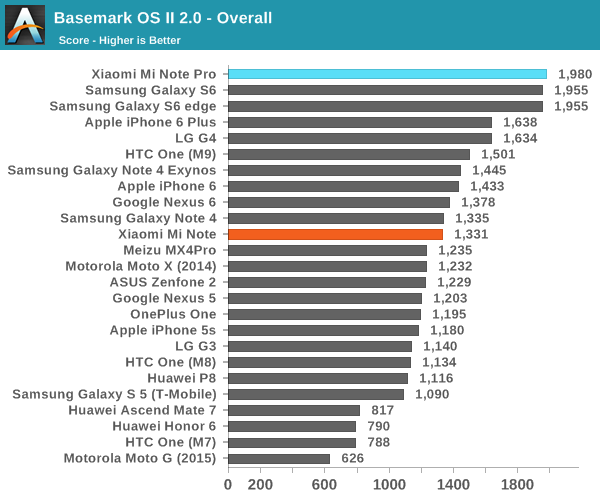
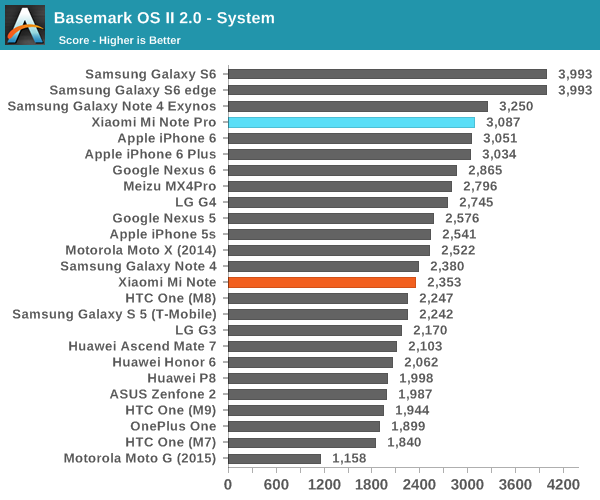

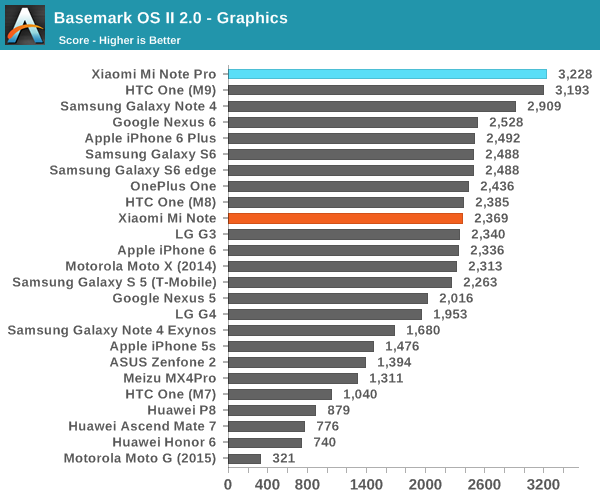
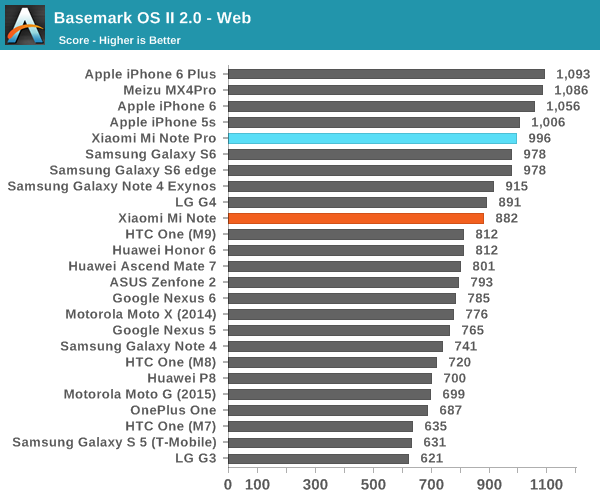
In Basemark OS II we see that performance is roughly estimated to be equal to the Galaxy S6. It seems that most of this is coming from the NAND benchmark aspect and browser optimizations as in the System subtest the Mi Note is around the same level as the Exynos 5433. The graphics subtest shows performance is identical to the One M9, which suggests that the 30 MHz bump in clock isn't going to be particularly helpful.
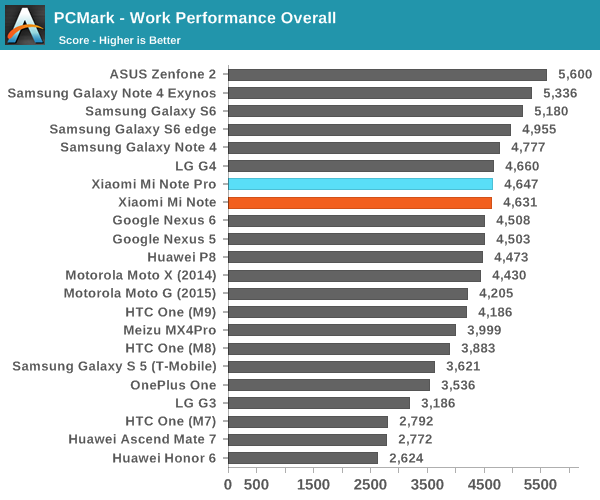
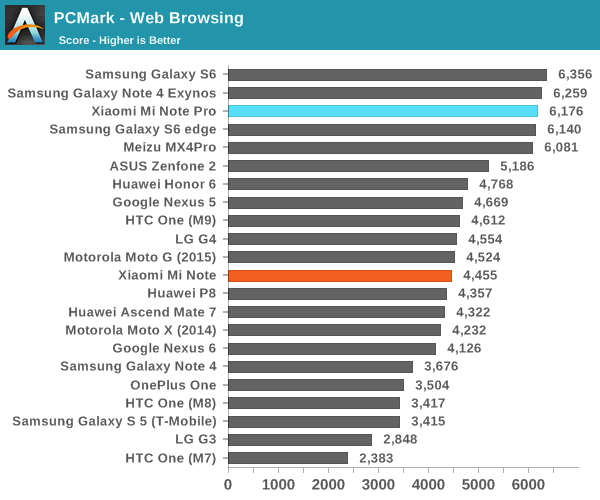
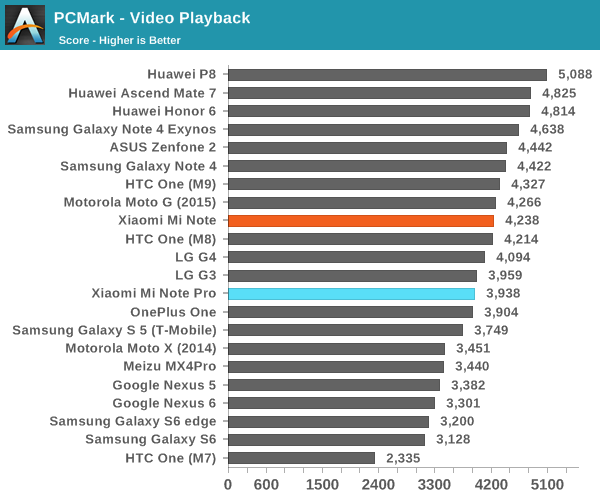
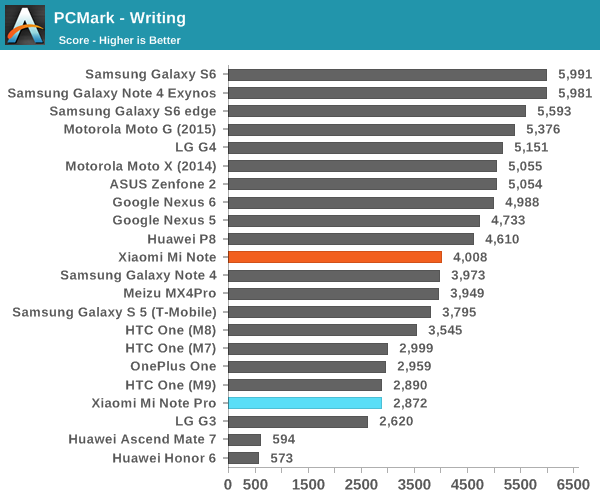
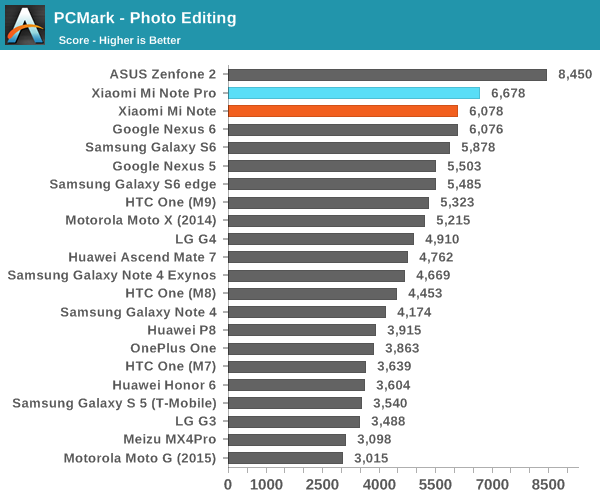
At this point it's pretty fair to say that the Snapdragon 801 is a known quantity when it comes to performance, but when it comes to the Snapdragon 810 it's still in some level of flux. For the Mi Note at least, this is mostly interesting at an academic level as a pure 2.5 GHz 4x Krait comparison relative to the Snapdragon 810. Overall, it looks like the Mi Note Pro is about the same performance as the G4, which makes sense because the governor usually only allows two A57s to stay online in all but the most extreme loads. However, performance has a wide relative variation in cases where the OEM has either invested a lot of time in optimizing their build of Android or not as much. It looks like web browsing is a major point of optimization for the Mi Note Pro as it is competitive with the Galaxy S6 in that test, but in areas like the writing subtest Xiaomi is falling behind somewhat. I suspect this is mostly a software optimization problem as PCMark is extremely sensitive to changes in Android version as seen in the Note 4 and Note 4 Exynos which are surpassing the Mi Note due to an OTA update to Lollipop despite the Mi Note's use of a performance governor.
Overall, performance of Snapdragon 810 in these mostly CPU-bound tasks is acceptable. We can still see some performance gains over Snapdragon 801 and 805 but relative to the Exynos 7420 competition things aren't quite as rosy. Of course, we can talk about software optimization but in Basemark OS II the Mi Note only squeaks by due to a high NAND performance score rather than a strong showing in any SoC performance test. In PCMark we see a similar story of some tests where the Mi Note Pro is doing well, but others where it falls short to give an average score overall. Whatever the case, it's clear that the Mi Note Pro does have a good amount of performance on tap. The Mi Note is also clearly capable of being a strong performer as seen in the performance mode benchmarks, but the balanced governor mode needs to be much better to exploit that performance. Both phones should have enough CPU performance to do pretty much any everyday task.










94 Comments
View All Comments
DigitalFreak - Friday, September 11, 2015 - link
You guys need to say if a phone is a US model up front. I'd rather not waste my time reading a review of something that's only available in Asia/Europe.Daniel Egger - Friday, September 11, 2015 - link
I agree but for the exact opposite reason. But on the bright side the non-availability of subsidised US versions means that we we non-US readers don't have to have to look up the unsubsidised prices elsewhere to actually get a feel for the real price...Jimbo - Friday, September 11, 2015 - link
Yet your eventual cost for the very same hardware is always more, so how is that a "bright side" again?Daniel Egger - Friday, September 11, 2015 - link
I've no idea what you're trying to say. I applaud every attempt at providing comparable data: When AT reviews a laptop they'll tell you the MSRP (and street price), when they look at a phone they'll typically tell you some bullshit subsidised price which has only a meaning in the US and nowhere else in the world (and also only if you're actually looking to buying the device on contract).mkozakewich - Saturday, September 12, 2015 - link
I really wish they'd stop doing that. Because of stuff like that, I'm sure most people don't realize their phones are worth more than a few hundred dollars.duploxxx - Friday, September 11, 2015 - link
order this phone through web so available everywhere. reading something on technology is wasting time? time for you to stay in the apple store......DigitalFreak - Friday, September 11, 2015 - link
I'm the furthest thing from an Apple fan you'll find, moron. I'm not interested in buying a phone that most likely won't work on many of the US bands.You, on the other hand, should spend less time reading about technology and focus on learning the basics of the English language.
jordanclock - Friday, September 11, 2015 - link
Instead of being ass, you could just look up the available bands on a site like gsmarena. Not every product reviewed on Anandtech is going to be applicable to you. In this case, the phone does not support LTE on any US carriers but should support HSPA+ on ATT and T-Mobile.DigitalFreak - Friday, September 11, 2015 - link
As a service to their readers, all AT needs to do is add one sentence. As for the rest, when someone attacks me they get it right back.Have a wonderful day.
Vorl - Friday, September 11, 2015 - link
I agree. They very rarely review anything that isn't for consumption in the US. I would also rather not waste my time reading about something that isn't available. Yes, it's a waste. There isn't anything here that's ground breaking tech wise, so nothing to "learn". It's just a matter of how they put the package together. if isn't nothing I can use, why would I care?